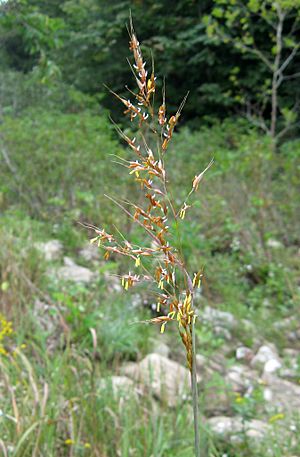Indiangrass facts for kids
Quick facts for kids Indiangrass |
|
|---|---|
 |
|
| Indiangrass in bloom | |
| Scientific classification | |
| Genus: |
Sorghastrum
|
| Species: |
nutans
|
| Synonyms | |
|
|
Indiangrass (Sorghastrum nutans), also called Indian grass, is a tall, native grass found across North America. It grows especially well in prairie areas. This important plant is even the official state grass for both Oklahoma and South Carolina. Indiangrass is a key part of many natural environments.
| Top - 0-9 A B C D E F G H I J K L M N O P Q R S T U V W X Y Z |
About Indiangrass
Indiangrass is a type of grass that can grow very tall. It often reaches heights of 3 to 7 feet (about 1 to 2 meters). Sometimes, it can even grow taller than a person! It has strong, upright stems and long, narrow leaves.
What Indiangrass Looks Like
The leaves of Indiangrass are usually green or blue-green. They turn a beautiful golden-bronze color in the fall. At the base of each leaf, there's a small, pointed part called a "rifle-sight" ligule. This unique shape helps you identify Indiangrass.
When it blooms, Indiangrass produces a feathery, golden-brown seed head. These seed heads are often 6 to 12 inches (15 to 30 cm) long. They look like a narrow plume or a fancy feather. The tiny flowers inside these seed heads have bright yellow parts called stamens.
Where Indiangrass Grows
Indiangrass is native to a large part of North America. You can find it from southern Canada all the way down to northern Mexico. It grows well in open areas like prairies, savannas, and open woodlands. It prefers sunny spots and can grow in many different types of soil.
This grass is very tough and can handle dry conditions once it's established. It's often found alongside other famous prairie grasses, like Big bluestem and Switchgrass.
Life Cycle of Indiangrass
Indiangrass is known as a "warm-season" grass. This means it does most of its growing during the warm summer months. It starts to grow in late spring and reaches its full height by late summer or early fall.
How it Reproduces
Indiangrass reproduces mainly by seeds. The golden-brown seed heads that appear in late summer are full of tiny seeds. These seeds are spread by wind or by animals. Once the seeds fall to the ground, they can sprout and grow into new plants the next spring.
It also grows in clumps, or "bunches." Over time, these bunches can get bigger as the plant spreads slowly from its base. This helps it form strong, stable patches in the prairie.
Why Indiangrass is Important
Indiangrass plays a very important role in its natural environment. It's not just a pretty plant; it's a vital part of the ecosystem.
For Wildlife
Many animals rely on Indiangrass. Its tall, dense growth provides excellent habitat for wildlife. Birds, like quail and pheasant, use it for nesting and shelter. Small mammals, such as rabbits and mice, also find protection among its stems.
The seeds of Indiangrass are a food source for many birds and small animals, especially in the fall and winter. Larger animals, like deer, might graze on its leaves when they are young and tender.
For the Environment
Indiangrass has deep roots that can go down many feet into the soil. These deep roots help to hold the soil in place, preventing soil erosion. They also help to improve the soil by adding organic matter.
As a native prairie grass, Indiangrass is very good at storing carbon from the atmosphere. This helps to keep the air clean. It's also very resistant to drought and wildfire, which are common in prairie environments.
For People
Historically, Native American tribes used Indiangrass for various purposes. Its strong stems were sometimes used for making brooms or other tools. Today, Indiangrass is often planted in prairie restoration projects. These projects aim to bring back native grasslands that have been lost. It's also used in landscaping for its beauty and toughness.
Images for kids
See also
 In Spanish: Hierba de don Carlos para niños
In Spanish: Hierba de don Carlos para niños





